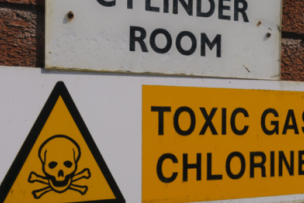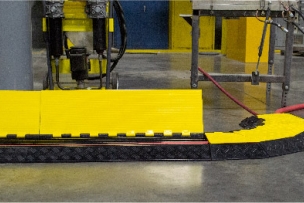Read on to discover how you can prepare your workplace and protect your employees.
What Is an Arc Flash?
An arc flash is a discharge of energy that occurs when an electrical current travels between two circuits or between a circuit and the ground. “We think of arc flashes in relation to utilities or an electrical panel,” says Mary Ann Merikoski, director of product-apparel for Mechanix Wear, “but it can occur anywhere an electrical current has an opportunity to escape its intended path.”
The danger of an arc flash is not in the initial flash itself, but in what happens after: The electrical current released into the air can set fire to clothing and nearby materials, resulting in severe burns and structural damage.
Read more: 5 Arc Flash Safety and Injury Prevention Tips for Manufacturing
Common Causes and Risks
Arc flash dangers are often overlooked because, as Merikoski says, “many electricians go their whole careers without being exposed to an incident.” Studies vary as to the frequency, but there may be between 600 and 2,000 arc-flash-related burn injuries each year.
These incidents can be caused by equipment failures, such as a tripped breaker; metal-to-metal contact from improperly insulated tools or equipment; work on energized electrical systems; or poorly maintained systems that result in faulty wiring or loose connections. Most of these issues are caused by humans and can be rectified by regular care and proper training, Truesdale says. “You have to keep up with general maintenance of electrical systems just like you would with a car,” he says.
OSHA and NFPA Safety Requirements
The Occupational Safety and Health Administration (OSHA) recently published updated guidance aimed at keeping employees safe from the dangers of arc flashes. The information includes:
- Outlining the use of personal protective equipment (PPE) based on incident energy levels
- Clarifying common misconceptions related to low-voltage and de-energized electrical systems
In addition to OSHA’s guidance, manufacturers must follow the National Fire Protection Association’s (NFPA’s) 70E standard for electrical safety in the workplace, which includes:
- Conducting routine risk assessments to determine potential hazards
- Establishing safe work zones and boundaries to reduce the fallout from a potential arc flash
- Providing the appropriate PPE for the electrical environment and ensuring that it is used correctly
- Keeping the company’s policy updated and training employees regularly
Truesdale recommends auditing your company’s policy and aligning it with OSHA’s guidelines and NFPA’s standards, along with state and local requirements, to prevent getting a citation. “OSHA will hold you accountable to your policy,” he says.
Read more: Electrical Safety in Manufacturing: Debunking Myths Around Arc Flashes
Preventing Arc Flash Incidents
There are several steps you can take to reduce the risk of an arc flash and the resulting damage:
Inspect and Repair Your Equipment
Conduct an infrared study of your electrical systems every 12 to 18 months to determine which parts, including breakers and wiring, need to be replaced. “We use a thermography camera to see where there’s an electrical issue, like faulty wiring or a breaker that’s tripping,” Truesdale says, “and that tells us what needs to be replaced to prevent an electrical fire.”
Label Electrical Sources Appropriately
Every electrical panel should have a label that indicates the safe working boundary and the type of PPE required to work within that boundary. “The person performing the work needs to know what kind of PPE to wear in order to be protected from what is behind that panel,” Truesdale says. “When there is no label, there is no way to tell what protection you need.”
Establish Safe Work Practices
Follow lockout/tagout procedures to de-energize electrical equipment before working on it, establish a safe distance from energized equipment, and wear the proper PPE as noted on the energy source’s label when working within the arc flash boundary.
Train Your Employees
Once you have a policy and procedures in place, it is vital to provide annual training to employees who work on or near electrical equipment, to ensure that they adhere to the safeguards.
Read more: The Development of Arc Flash Suit Fabrics: Flame-Resistant PPE for Electrical Hazards
Essential PPE and Care
Even with the best procedures in place, an arc flash is always possible when working with electricity. That’s why wearing the proper arc-rated and fire-resistant PPE is critical.
“The technology of the apparel is in the fabrics themselves,” Merikoski says. “You want to make sure that you are working with a PPE vendor who is using NFPA 70E-compliant fabrics, because that’s where the protection comes from.”
Arc flash PPE includes:
Employers should also ensure that the calorie rating of all PPE matches the label of the equipment that employees are working with, and that the protective equipment is worn appropriately. “If your coveralls are open halfway down because it’s hot and you have a shirt underneath that has a high polyester content, that can melt or catch fire,” Merikoski says.
Finally, she advises that caring for and maintaining PPE are just as important as wearing it properly. “Oils can significantly interfere with the performance of fabrics, and garments won’t perform properly if they’re not worn in a clean state,” she says. “It is very important to have a maintenance and inspection process in place to ensure that the PPE remains effective.”
How are you protecting employees from arc flash dangers? Share your tips in the comments.





Talk to Us!
Leave a reply
Your email address will not be published. Required fields are marked *